Hyperthyroidism in elderly cats: Diagnosis and treatment.
The thyroid is a two-lobed gland located in the neck, with one lobe located on each side of the trachea (windpipe). The thyroid gland produces thyroid hormone, a substance that is transported to every cell in the body via the bloodstream.
The primary function of thyroid hormone is to enhance the rate at which cells function. Too much hormone makes the cells work very fast, while too little causes the cells to slow down.
What is hyperthyroidism?
Hyperthyroidism occurs with excess thyroid hormone production.
It is rare in dogs, but is one of the most common diseases diagnosed in cats seven years of age and older.
Clinical signs for hyperthyroidism vary among affected cats. The most common signs are weight loss, increased appetite, patchy hair loss, failure to groom, increases in water intake and urine output and restlessness or nervousness. Vomiting and diarrhea are also common.
Diagnosis.
To diagnose hyperthyroidism, blood tests of thyroid activity are necessary. Most hyperthyroid cats will reveal an elevated thyroid hormone (T4) in their bloodstream. However, a small percentage of cats do not have a “diagnostic” elevation in their blood T4 level. In these instances, further testing of the thyroid function should be considered.
Treatment.
Three different treatments are available for managing hyperthyroidism in cats. Hyperthyroid cats that are not treated tend to become increasingly ill, but treatment will usually restore a patient’s health.
 Treatment option: Oral medication.
Treatment option: Oral medication.
One treatment option involves the use of an oral medication called methimazole (Tapazole®). Methimazole works by reducing the thyroid gland’s ability to produce T4. This medication is readily available and relatively inexpensive. The major disadvantage to methimazole is that it must be used for the remainder of the cat’s life. Also, it may also cause vomiting, loss of appetite, liver damage and decreases in white and red blood cells and platelets idiosyncratically.
Full blood work is necessary within one week of the introduction of methimazole to ensure that the liver and bone marrow are tolerant to the drug. Finally, serial reassessment of thyroid function is required to confirm the methimazole dose is controlling the hyperthyroidism (usually every three months). Methimazole, if tolerated, is often recommended in patients with concurrent chronic renal (kidney) insufficiency.
Treatment option: Surgical removal of abnormal thyroid gland.
Another treatment option is surgical removal of the abnormal thyroid gland(s); this procedure is called thyroidectomy. Although surgery does resolve the hyperthyroidism quickly, it requires anesthesia and hospitalization, and some hyperthyroid cats are at increased anesthetic risk. Rarely parathyroid glands may be accidentally removed during thyroidectomy. This surgical complication results in hypocalcemia (low blood calcium) and lifelong calcium supplementation. Finally, surgical correction of thyroid hyperactivity may be detrimental to the patient’s kidney health. Rapid reduction in thyroid activity alters renal (kidney) blood flow. In patients with concurrent renal disease, this rapid change in blood flow may aggravate the renal disease.
Treatment option: Radioactive iodine (I-131).
The third and generally best treatment option is the use of radioactive iodine (I-131). Iodine is the primary building block of thyroid hormone and is absorbed readily by thyroid gland cells whether the iodine is radioactive or not. Radioactive iodine is taken up by thyroid cells (preferentially gathering in abnormal thyroid cells) and irradiates these abnormal cells, destroying them.
There are few disadvantages to I-131 therapy. Patients receiving I-131 treatment must remain in the hospital until their radioactivity drops below a specified threshold. Visitation during this hospital stay is  not permitted because of state and federal mandates. This typical hospital stay is generally 5 to 7 days. Also, some cats treated with I-131 may become irreversibly hypothyroid, a condition that requires lifelong thyroid hormone replacement therapy. Finally, a small percentage of patients that undergo radioactive iodine therapy may develop overt renal disease.
not permitted because of state and federal mandates. This typical hospital stay is generally 5 to 7 days. Also, some cats treated with I-131 may become irreversibly hypothyroid, a condition that requires lifelong thyroid hormone replacement therapy. Finally, a small percentage of patients that undergo radioactive iodine therapy may develop overt renal disease.
Talk to your family veterinarian about the options available so you can make an informed decision about the most appropriate treatment for your cat.
 Treatment option: Oral medication.
Treatment option: Oral medication.

